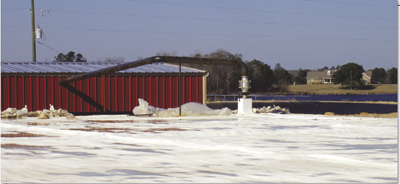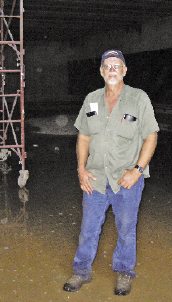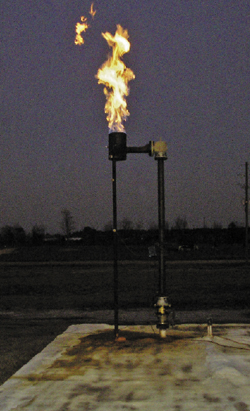
The Wright Family Dairy finds that
the mixed plug-flow digester helps not only save on bedding, but also
helps improve water quality and generate income.

|
| The digester is currently producing approximately 180 kilowatts per hour – enough to power approximately 600 homes. And Pete is able to sell the excess energy he does not use, after running the digester system, to the public utility. |
The Wright Family Dairy finds that the mixed plug-flow digester helps not only save on bedding, but also helps improve water quality and generate income.
It all started when Pete Wright started looking for ways to save money on bedding. The Wright Family Dairy, located in Baxley, Georgia, used sawdust bedding for its 1200 cows at a cost of more than $100,000 a year. Pete was also facing some serious environmental issues – the wells on his 690 acre farm were showing higher than acceptable nitrogen levels.
When attending a dairy show in Madison, Wisconsin, he found the solution to both of his problems. It was a mixed plug-flow digester system designed by Wisconsin based GHD Incorporated, a company that has successfully designed systems throughout the U.S. GHD’s anaerobic digester system could create quality bedding without composting, produce electricity to help reduce costs, and reduce the nitrogen and phosphorus level in the water.
Based on these benefits, as well as testimonials from farmers describing increased crop yields and low maintenance, Pete decided to incorporate the system – GHD would do the designing and Pete would be responsible for construction. Upon completion, Wright Family Dairy would be the first (and to-date the only) dairy in the southwest U.S. with such a system.
Reservations raised
Before Pete even got started, nay-sayers stepped forward to voice their doubts.
“A fellow from Georgia Tech wrote the USDA saying that the system would not work,” says Dwight Wingo, a geologist at the Wright Family Dairy who has been involved in the project from the start. “No matter what the power people tell you, they just won’t work with you. Luckily, we didn’t find that to be the case.”
In fact, although there were some surprises along the way, the exceptional help the dairy received from the public utility company is one of the reasons they are contemplating the installation of a second digester. (But more about that later.)
Installation
 |
| Pete Wright of the Wright Family Dairy in Baxley, Georgia, uses a mixed plug-flow digester system to help create quality bedding for his 1200 cows, alleviate higher than acceptable nitrogen levels in his farm wells and produce electricity. |
One of the advantages of the mixed plug-flow system was that it did not require substantial modifications to the dairy. GHD’s design did, however, have to take into account unique aspects of Pete’s dairy. “Most dairies have free stalls and Pete has what he calls pack barns, which made it a little different,” explains Dwight. “With most digesters they are getting mostly manure. Here the bedding was going into it too.”
With GHD’s system, the manure and bedding are washed into an existing 50 foot by 100 foot concrete basin. Gravity fed, the waste flows into the first of three compartments. From that first compartment, the manure is pumped over an Agpro screen separator into the second compartment – commonly referred to as the mix pit. Liquid held in the third compartment (recycled wash water from the barns) is added to the mix pit until the manure reaches the right viscosity: 14 percent solids. The mixture is then pumped to the digester. The 800,000 gallon digester is fed four times a day: early morning, late morning, mid afternoon and then at six o’clock. Waste retention time in the heated digester is 21 days.
“The digested material comes off continuously throughout the day,” says Dwight. “That material is separated using an Agpro screw press. The liquids go to the holding lagoon to be applied to the fields and the solids go into a barn where they dry up and are used as bedding for the cows. It’s just a continuous loop.”
The drying process is quick. Pete has found that by the time the old bedding is removed, the new has been added, and the cows are back to the barn after a milking, the bedding is already dry. While the bedding is being replaced, the liquids have been pumped by another Agpro pump to a 200 foot by 50 foot synthetically lined lagoon and eventually applied to approximately 400 acres.
It took a bit of time to adjust the farm’s manure management practices to work in sync with the digester. For example, Pete had to change his barns so that he could push bedding into the flush area so it could get to the mix pit. But once the kinks were worked out, the results were all but amazing.
Power bill
The digester is currently producing approximately 180 kilowatts per hour – enough to power approximately 600 homes. And Pete is able to sell the excess energy he does not use, after running the digester system, to the public utility.
“This last month we got a cheque for $5100,” says Dwight. “We can’t speak highly enough about the Fatila Electrical Co-op. They have done nothing but work with us. Where we thought we would be getting three to four cents per kilowatt-hour, we’re getting six.” In addition, Pete is selling carbon credits to the Chicago Stock Exchange.
Bedding costs eliminated, improved wells
Pete is no longer facing the high costs of bedding. In fact, the money he is saving on bedding alone will pay for the digester over time. Based on initial calculations, the combined savings he will realize using the system are approximately $200,000 a year.
High nitrogen levels are also a thing of the past. First, the system required bringing the cows under barns and out of the fields, and that helped bring the wells into compliance. Secondly the liquid being applied to the fields is more beneficial. “Because pre-digested
manure has plant-available nitrogen of about 40 or 45 percent, and post-digested level is 70 to 75 percent, the plants are able to take up more nitrogen and less is getting down to the water table,”
says Dwight.
Pete and Dwight were told by the farmers in Wisconsin before they installed the system that the nitrogen availability would significantly improve their silage crops. “We haven’t seen those results
yet, but there are other factors involved,” says Dwight, “like the current drought we’re experiencing.”
Adding up the costs

|
 |
| The Wright family received a $200,076 USDA grant to help offset the cost of constructing the digester system on the farm. The entire system cost between $1.2 and $1.5 million and included construction of a building to house the digester, new pumps, a separator screw press and electric meter boxes. It also required hiring help, because it takes about five hours a day to operate the digester and engine. |
Pete and Dwight do not really see a downside of this project, except that it does require a substantial cash investment to get started. This system costs between $1.2 and $1.5 million – $800,000 of it being the digester itself.
Dwight suggests that farmers looking at a digester system take into account all the costs in addition to the digester. For Wright Farm, it included the building to house the digester, new pumps, a separator screw press and electric meter boxes. It also required hiring help, because it takes about five hours a day to operate the digester and engine. If the Wrights had free stall barns, GHD says the time requirement would generally be between one-half and two hours a day.
“We got a $200,076 USDA grant, but it was based on $800,000. We should have based it on the cost of the digester and the incidentals,” says Dwight.
Future benefits
Where some farmers may have seen themselves at the end of successful project, Pete sees it as the beginning. One of the next steps is to take the heat from the digester and start using it to heat that water to clean their milk parlor, and also use it in other areas.
But the more exciting evolution is to add other waste to the digester. “Pete has already started to add waste orange juice and salad oil,” says Dwight. “We’re also talking to egg processors that have a lot of waste eggs.”
Farm managers are also talking to people about adding FOG (fats, oils and greases), which are responsible for clogging up sewage system in the cities, and they are looking into glycerol, a by-product of bio-diesel production. Why the excitement? “These waste products are what’s really going to make the difference on whether these digesters work or not,” says Dwight. “When you add the additional waste, we actually get less solids and more electricity. The waste makes the bugs more active, they eat more of the solids.”
 |
| Wright Family Dairy management hope to take the heat generated by the digester and start using it to heat the water required to clean the farm’s milking parlor and other areas in the operation. There are also plans to start incorporating other waste to help feed the digester. |
The waste is added directly to the mix pit just prior to pumping the mixture to the digester. “In this case, you basically put the greases in there and for all intents and purposes, it goes away,” adds Dwight. “It’s really a phenomenal project. We’re looking at starting that right away.”
It is an exciting next step because Pete would not only be producing more electricity, but could also be paid to take by-products, like FOG, as well. In Washington State, some companies are paying five cents a gallon to have it taken versus paying to have it land applied or put in a landfill.
There is one drawback. “We’ll get a lot more electricity, but a little less bedding,” says Dwight. But it is a give and take situation that Pete is looking forward to facing.
A second digester
Pete has seen such great results from the project and support from the local utility that he is looking for a dairy that will let him build a second digester system. “These other waste streams are really going to make the digesters viable,” says Dwight. “And there’s plenty of waste around.”